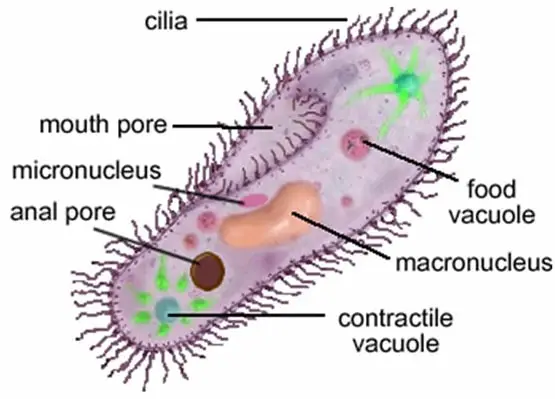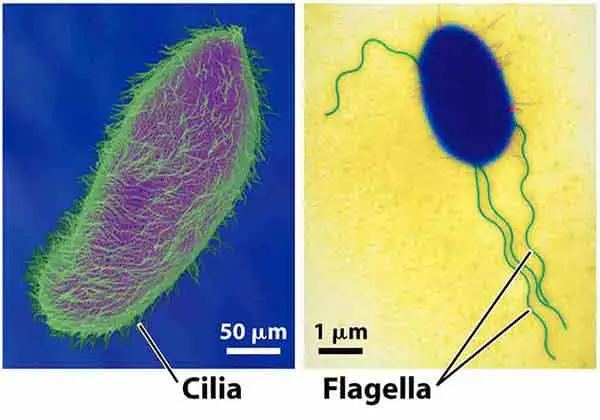Cell organelles play a vital role in various cellular functions. Two of the most important cell organelles are cilia and flagella. They are similar in structure but are quite different in functions. Cilia are short in structure and a single cell consists of hundreds of cilia. There are only a few flagella per cell but they are longer than the cilia.
Motile cilia and flagella in eukaryotic cells are identical in structure. Each contains two central single microtubules and a bundle of a total of nine fused pairs of microtubule doublets. The interaction between the microtubules causes the movement of cilia and flagella.
Non-motile cilia do not have microtubules. In a prokaryotic cell, flagella are filamentous protein consists of flagellin. The flagella or prokaryotic cells are thinner than the eukaryotes. (1, 2, and 3)

Image 1: The image above is a closer representation of cilia.
Picture Source:3.bp.blogspot.com
Types of cilia
- Motile cilia – These cilia are located on the cell’s surface and beat in a rhythmic motion. You can found them in the lining of the trachea. Their primary goal is to get rid of mucus and dirt so that the air that gets in and out of the lungs are clean. They can also be found in the fallopian tubes. They help move the ovum from the ovary to the uterus.
- Non-motile cilia – They do not beat but are present in all mammal cells. They are abundant in the sensory organs such as the eyes and nose. (3, 4)

Image 2: A closer look at flagella.
Picture Source: i2.wp.com/orbitbiotech.com
Types of flagella
- Bacterial flagella – They are helical filaments and they rotate like screws. The number of flagella in every cell varies. Their main goal is to the bacteria motile.
- Archaeal flagella – They look like the bacterial flagella but completely unique in structures. They don’t have a central channel.
- Eukaryotic flagella – They are cellular projections that are complex in nature. They move back and forth. The flagellum is used for propelling such as in the sperm cell. (3, 4, and 5)
Flagella and cilia are important as they are responsible for various bodily functions. If they don’t function well, they could cause problems in humans. Some of the problems that might occur include:
- The renal tube cells contain cilium and a defect can lead to polycystic kidney disease.
- The fallopian tube contains cilia and if these cilia do not function well, then there is a tendency of ectopic pregnancy. The fertilized ovum will not reach the uterus and will remain in the fallopian tube.
- Male infertility could be linked to the dysfunction of the flagellum. It causes sperm to be immotile. It can’t swim its way to the ovum. (4, 5, 6, and 7)

Image 3: A comparison image between cilia and flagella.
Picture Source: microbiologyinfo.com
The table below shows the differences between cilia and flagella.
| Key Differences | Cilia | Flagella |
| Meaning | Hair-like appendages, short and extends from the surface of living cells. | Thread-like appendages, long and located on the surface of living cells. |
|
Length | Short | Varies in length but are longer than cilia |
| Density | Each cell contains hundreds of cilia. | Less than 10 flagella per cell. |
| Movement | They move in a rotational motion. | They move like a wave-like motion. |
| Pace | They are fast-moving organelle. | They are slow-moving organelle. |
| Where can they be found? | Eukaryotic cells | Found in both eukaryotic and prokaryotic cells |
| Cross-section | Have nexim arm | Do not have nexim arm |
| Beating | They beat in a coordinated rhythm. | They beat independently. |
| Functions | Locomotion Feeding Aeration Circulation | Its primary and only function is for locomotion. |
| Energy production | They use kinesin; contains ATPase activity responsible for producing energy to perform a specific movement. | They use a proton-motive force by the plasma membrane. |
Are there any similarities?
- They both arise from the basal body, which is a small granular structure.
- They both outgrow from the cell’s plasma membrane.
- They both have axoneme, a central filament. Axoneme has a total of 11 microtubules. Nine are in pairs (doublet) while the two are located in the center (singlet).
- Their primary function is for locomotion.
Both cilia and flagella are microscopic hair-like structure necessary in various bodily functions. Cilia are slender and shorter than flagella. They are present only in eukaryotic cells. Flagella are present in both eukaryotic and prokaryotic cells.
When it comes to movement, cilia move in a rotational motion and move very fast. Flagella, although move slowly, they move independently and in a whip-like motion. Although cilia are smaller than flagella, they perform complex tasks such as locomotion, circulation, excretion, and aeration. Flagella are only involved in locomotion. (8, 9, and 10)
References
- https://www.diffen.com/difference/Cilia_vs_Flagella
- https://microbiologyinfo.com/differences-between-cilia-and-flagella/
- https://biodifferences.com/difference-between-cilia-and-flagella.html
- https://byjus.com/biology/difference-between-cilia-and-flagella/
- https://microbenotes.com/differences-between-cilia-and-flagella/
- https://www.thoughtco.com/cilia-and-flagella-373359
- https://www.ncbi.nlm.nih.gov/books/NBK21698/
- https://pediaa.com/difference-between-cilia-and-flagella/
- https://sciencing.com/main-functions-cilia-flagella-10572.html
- https://www.quirkyscience.com/differences-flagella-and-cilia/
